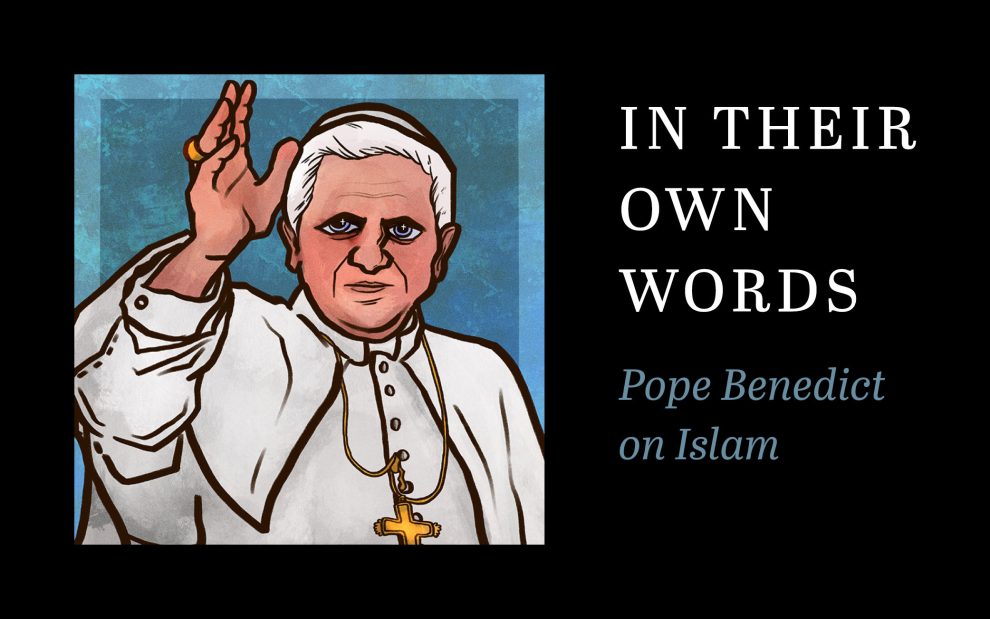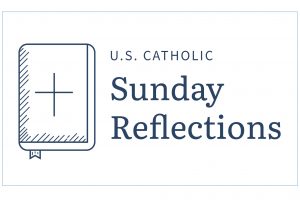In Their Own Words is a new web column from U.S. Catholic. In these essays, academics and other experts provide short, evidence-based explanations of prominent Catholic figures’ views on an array of topics of interest to the church and offer resources for finding further accurate information.
Walking in socked feet across the patterned carpet, Pope Benedict XVI looked up into the spectacular domed ceiling of the Blue Mosque in Istanbul. It was 2006 and only the second time a pope had visited a mosque. The first was in 2001 when his predecessor, Pope John Paul II, visited the Umayyad Mosque of Damascus, Syria.
Standing alongside the mufti Mustafa Cagrici, Pope Benedict lowered his head in a shared “moment of prayer,” his hands folded across his torso. His visit to the Turkish mosque had been added to his itinerary last minute. Just two months prior, he had given a speech that touched briefly on Islam—something that would become the most significant, and problematic, moment of his legacy in Catholic-Muslim relations.
In September 2006—just a day after the fifth anniversary of the September 11 attacks in the United States—Benedict had given a lecture at the university in Regensburg, Germany on the relationship between faith and reason. To introduce his topic, he recounted a dialogue between a 14th-century Christian emperor, Manuel II Paeologus, and a Muslim scholar. He quoted the emperor, who said, “Show me just what Mohammed brought that was new, and there you will find things only evil and inhuman, such as his command to spread by the sword the faith he preached.”
Both Christians and Muslims globally were stunned and disappointed that Pope Benedict had made such a remark. Benedict’s successor, then-Archbishop Jorge Bergoglio of Buenos Aires, lamented that “these statements will serve to destroy in 20 seconds the careful construction of a relationship with Islam that Pope John Paul II built over the last 20 years.” Not only was Benedict’s use of the quotation an inaccurate and disrespectful portrayal of Islamic history and of the Prophet Muhammad, but it also invoked harmful and untrue stereotypes about Muslims being inherently violent, barbaric, and evil.
In response, 30 Muslim leaders from around the world responded with an open letter to the pope, seeking to correct his portrayal of their faith. A year later, more than 100 Muslim scholars also issued a groundbreaking document called “A Common Word,” in which they affirmed core Islamic values of love of God and love of neighbor and articulated the need for Christians and Muslims to establish positive relationships on the basis of these common principles. In the immediate aftermath of Regensburg, a small number of Muslims in different places attacked churches and Christian individuals in retaliation for the pope’s comments, leading some Catholics to laud the pope’s words as prophetic.
In the days after the speech, Benedict expressed regret that his comments caused offense (though stopping short of a full apology) and insisted that the quote did not reflect his personal views. Still, the pope had chosen to use the emperor’s line in his speech, and he did so with purpose—to introduce a claim that Islamic theology can naturally lead people to attempt to spread faith through violence. Many scholars (both Muslim and non) refute this portrayal of Islam, noting Qur’anic passages to the contrary, the wide theological diversity among Muslims, and the important place of reason in Islamic thought.
Even before Regensburg, Benedict had taken steps to downgrade dialogue with Muslims. He had removed a leading Catholic scholar of Islam, Archbishop Michael Fitzgerald, from his post as the head of the Pontifical Council for Interreligious Dialogue (PCID) and relocated that body under the Pontifical Council for Culture. This was done, at least in part, out of Benedict’s conviction that the doctrinal differences between Christianity and Islam made theological dialogue difficult if not impossible. Before Benedict was pope, he served as the head of the Vatican’s doctrinal office, the Congregation for the Doctrine of the Faith. In 2000, the CDF released the controversial document Dominus Iesus, which, in emphasizing the necessity of Christ for salvation, lamented what it called “religious relativism” and referred to other religions as “gravely deficient.”
Pope Benedict’s approach to Islam was informed, at least in part, by the Egyptian Jesuit priest and scholar Samir Khalil Samir. A core advisor who has praised Benedict’s approach and claimed to share “the same line of thinking,” Samir has written and spoken of Islam in reductive terms, obscuring the diversity of the tradition and arguing that the violence of militant groups is an authentic application of Islam. In this way, Samir’s worldview shares much in common with the American writer Robert Spencer, a former Catholic well-known (and widely criticized) for mainstreaming Islamophobia in the United States.
In the months and years after his Regensburg speech, Benedict made efforts to repair the relationship with Muslims globally and to reiterate the church’s positive teaching on Islam. Often quoting from the documents of the Second Vatican Council, he reminded audiences that the church “looks with esteem” on Muslims, and that Muslims, too, “worship God who is one, living and subsistent; merciful and almighty, the creator of heaven and earth, who has also spoken to humanity.” He also reinstated the PCID and made a well-respected cardinal its prefect. Several formal dialogues were held between Vatican officials and Muslim leaders from al-Azhar University in Cairo, until they were suspended by the latter, citing the pope’s frequent mention of violence committed by Muslims and his relative silence over harms committed by Western powers against Muslims in the Middle East.
In the wake of Benedict’s retirement and Pope Francis’ ascension to the papacy in 2013, the Vatican took further steps to rehabilitate Catholic-Muslim relationships. In his early days as pontiff, Francis spoke of his intention to give special focus to dialogue with Muslims, and Al-Azhar immediately showed interest in resuming the relationship with the Vatican. Since then, Francis has forged bonds with Muslim communities around the world. Perhaps most notably, he signed the groundbreaking Document on Human Fraternity with al-Azhar’s Grand Imam Ahmed al-Tayyeb.
Despite Pope Benedict XVI’s missteps in Catholic-Muslim relations, he still sought to build positive relationships between the two faiths. In his second visit to a mosque, in Amman, Jordan in May 2009, he reminded both groups that “together, Christians and Muslims are impelled to seek all that is just and right.” That is a message that all of us can carry forward today.











Add comment